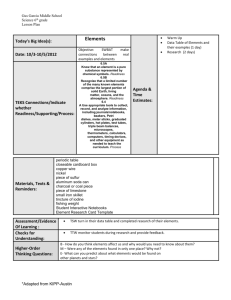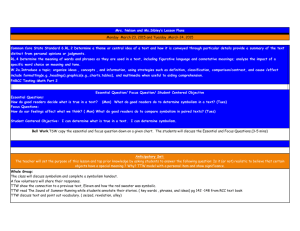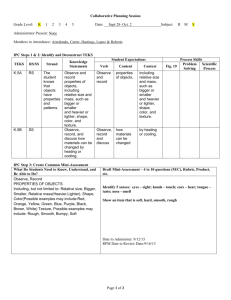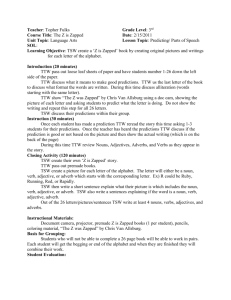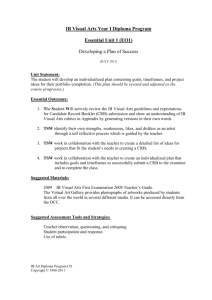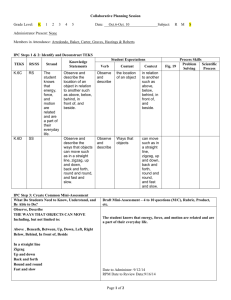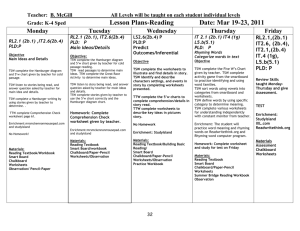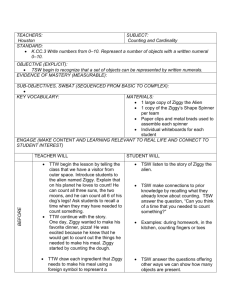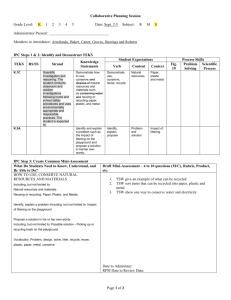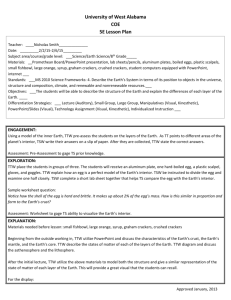File ela sept 7-11 - Judson Independent School District
advertisement
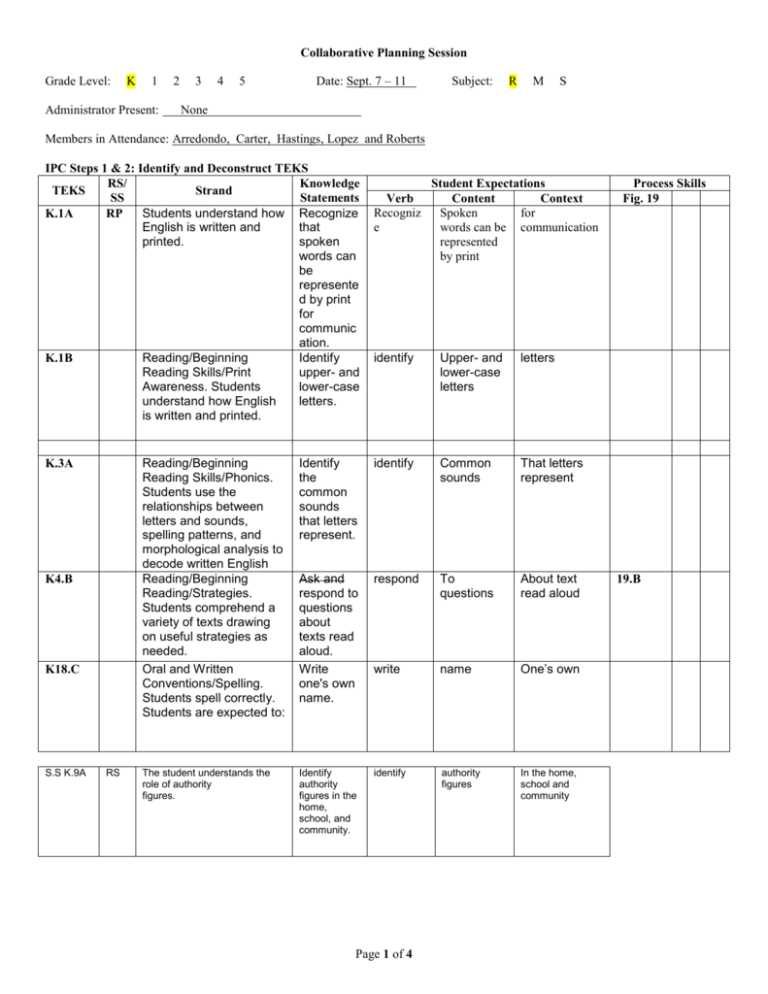
Collaborative Planning Session Grade Level: K 1 Administrator Present: 2 3 4 5 Date: Sept. 7 – 11 Subject: R M S None Members in Attendance: Arredondo, Carter, Hastings, Lopez and Roberts IPC Steps 1 & 2: Identify and Deconstruct TEKS RS/ Knowledge TEKS Strand SS Statements K.1A RP Students understand how Recognize English is written and that printed. spoken words can be represente d by print for communic ation. K.1B Reading/Beginning Identify Reading Skills/Print upper- and Awareness. Students lower-case understand how English letters. is written and printed. K.3A K4.B K18.C S.S K.9A RS Verb Recogniz e Student Expectations Content Context Spoken for words can be communication represented by print identify Upper- and lower-case letters letters Reading/Beginning Reading Skills/Phonics. Students use the relationships between letters and sounds, spelling patterns, and morphological analysis to decode written English Reading/Beginning Reading/Strategies. Students comprehend a variety of texts drawing on useful strategies as needed. Oral and Written Conventions/Spelling. Students spell correctly. Students are expected to: Identify the common sounds that letters represent. identify Common sounds That letters represent Ask and respond to questions about texts read aloud. Write one's own name. respond To questions About text read aloud write name One’s own The student understands the role of authority figures. Identify authority figures in the home, school, and community. identify authority figures In the home, school and community Page 1 of 4 Process Skills Fig. 19 19.B Collaborative Planning Session K.9B SS Explain how authority figures make and enforce rules. IPC Step 3: Create Common Mini-Assessment What Do Students Need to Know, Understand, and Be Able to Do? explain how Draft Mini-Assessment – 4 to 10 questions (M/C), Rubric, Product, etc. *Identify UPPER- AND LOWER-CASE LETTERS Including, but not limited to: In alphabetical sequence and random order; Consonants; Vowels *Identify THE COMMON SOUNDS THAT LETTERS REPRESENT Including, but not limited to: Identify lettersound association; Identify letters as consonants or vowels; Identify long and short vowel sounds *Write ONE’S OWN NAME Including, but not limited to: Capitalize the first letter *Speak IN COMPLETE SENTENCES TO COMMUNICATE Complete sentence – has a subject and predicate (verb or action) and expresses a complete thought (e.g., Dogs bark.) Note: Complete sentences include those that tell and ask. *Respond TO QUESTIONS ABOUT TEXTS READ ALOUD Including, but not limited to: Authority figures make and enforce rules Date to Administer: RPM Date to Review Data: Literal questions – (e.g., Who is the main character? Where is the story taking place? What is the story about?) Refer to K.Fig19B * Hold A BOOK RIGHT SIDE UP; Turn ITS PAGES CORRECTLY; Know THAT READING MOVES FROM TOP TO BOTTOM AND LEFT TO RIGHT * Listen ATTENTIVELY BY FACING SPEAKERS Including, but not limited to: In formal and informal settings; Ask RELEVANT QUESTIONS TO CLARIFY INFORMATION Including, but not limited to: Ask literal questions (e.g., who, what, where, when, why, how) Note: Refer to K.4B for related beginning reading strategies. *PURPOSE OF RULES: establish order, provide security and provide a safe environment *Rules in home and school: Establish order: School – respect others, stay in line Page 2 of 4 Collaborative Planning Session Provide security: School – volunteers sign in, visitors wear badges Provide a safe environment : School – don’t run in halls, practice storm drills, cross at crosswalk IPC Step 4 & 5 (in brief): Identify Instructional Activities/Strategies/ Methods Day NOTES Labor Day Holiday- NO SCHOOL MON. Word Wall Activities: TTW introduce word wall words: I, A, a TSW skywrite the letters and find them in the room. TTW distinguish between the word A,a and the letter a. TUES. Writers Workshop: TTW read a book about school authorities and explain who/what they are. TSW brainstorm to create a chart of who they think work in the school and who make the rules. I can understand how English is written and printed by creating a chart of authority figures in school. Daily Five – Round 1 – Read to self Focus Lesson: Introduce Letter A. TTW introduce the sound and the strokes for handwriting letter A. TSW skywrite the letter A and practice the sound. I can identify upper- and lower-case letters and the common sounds that letters represent by skywriting the letter A and produce the /a/ sound. Daily Five: Introduce Work on Writing Introduce anchor Chart for Work on Writing. Include the following: TSW create lists of what they can write about : make cards, write letters, write stories, paint word wall words, write word wall words Student expectations: 1.Write the whole time. 2. Stay in one spot. 3. Work quietly. 4. Choice of what to write 5. Get started quickly. Teacher expectations: 1. Work with students. Model correct and incorrect behavior Practice building stamina and developing independence. I Can use letter/sound correspondence by choosing a topic to write about and write independently.. Word Wall Activities: TTW review word wall words: I, A, a TSW skywrite the letters and find them in the room. TTW distinguish between the word A,a and the letter a. WED. Writers Workshop: TSW review the list from yesterday. TTW show a picture of Dr. Battle and Ms. Guzman and will discuss who they are and what they do at school. TSW draw a picture of Dr. Battle and Ms. Guzman and will label two ways they enforce the rules. I can understand how English is written and printed by labeling two ways authority figures make and enforce the rules. Daily Five – Round 1 – Read to self Focus Lesson: Review letter A sound and strokes. TSW brainstorm a list of words that begin with letter A. TTW make a matching anchor chart. TSW illustrate 3 words that begin with the letter A in their journals. I can identify upper- and lower-case letters and the common sounds that letters represent creating a list of words that begin with A /a/. Daily Five: Review Work on Writing Review: TSW create lists of what they can write about : make cards, write letters, write stories, paint word wall words, write word wall words Introduce anchor Chart for Work on Writing. Include the following: Student expectations: 1.Write the whole time. 2. Stay in one spot. 3. Work quietly. 4. Choice of what to write 5. Get started quickly. Teacher expectations: 1. Work with students. Model correct and incorrect behavior Practice building stamina and developing independence. I Can use letter/sound correspondence by choosing a topic to write about and write independently. Page 3 of 4 Collaborative Planning Session Word Wall Activities: TTW review word wall words: I, A, a TSW skywrite the letters and find them in the room. TTW distinguish between the word A,a and the letter a. THURS. Writers Workshop: TSW review the list of school authorities TTW show a picture of Ms. Yolanda and Ms. Bernadette. TSW will discuss who they are and what they do at school. TSW draw a picture of Ms. Yolanda and Ms. Bernadette and will label two ways they contribute to our school. I can understand how English is written and printed by labeling two ways authority figures contribute to our school. Daily Five – Round 1 – Read to self Focus Lesson: Introduce Letter B. TTW introduce the sound and the strokes for handwriting letter B. TSW skywrite the letter B and practice the sound. I can identify upper- and lower-case letters and the common sounds that letters represent by skywriting the letter B and produce the /b/ sound. - Daily Five: Review Work on Writing: Review: TSW create lists of what they can write about : make cards, write letters, write stories, paint word wall words, write word wall words Introduce anchor Chart for Work on Writing. Include the following: Student expectations: 1.Write the whole time. 2. Stay in one spot. 3. Work quietly. 4. Choice of what to write 5. Get started quickly. Teacher expectations: 1. Work with students. Model correct and incorrect behavior Practice building stamina and developing independence. I Can use letter/sound correspondence by choosing a topic to write about and write independently. Writers Workshop: Review and complete weekly activities Library: Each class will go according to their schedule Focus Lesson: Focus Lesson: Review letter B sound and strokes. TSW brainstorm a list of words that begin with letter B. TTW make a matching anchor chart. TSW illustrate 3 words that begin with the letter B in their journals. FRI. I can identify upper- and lower-case letters and the common sounds that letters represent by skywriting the letter B and produce the /b/ sound. Reading Folders: TSW read poems in their poem folders. I can identify upper- and lower-case letters and the common sounds that letters represent by skywriting the letter B and produce the /b/ sound. Page 4 of 4
